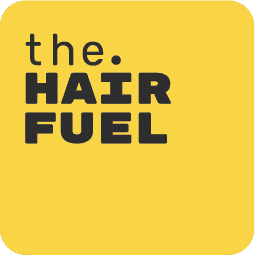HOW TO CARE FOR YOUR SCALP TO GROW HEALTHY HAIR
Hair says a lot about you. Very often, other than your face, it is one of the first things that people notice – it is one of the most prominent things on display. A lot can be said about a person based on the condition of their hair and scalp. Your state of health can be judged based on the condition of your hair, your lifestyle habits, your inner world – become more visible through the state of your hair. No wonder humanity has been obsessed with growing healthy hair through the centuries and millennia – trialling natural remedies, plant and animal (!) extracts, adopting hair care rituals and practices and recently exploring various supplements and medical treatments – all to grow great hair.
Hair has a Big Emotional Component

Although you have the freedom to do what pleases you with your hair, whether you cut it short (or very short) or decide to wear it long, people who see you perceive something about you just by looking at your hair. You might have even met people who stare at your hair instead of looking at your face while talking to you. Talk about high pressure to have a good hair day…
Another example is when someone is used to seeing you with long hair then all of a sudden sees you with a pixie cut or a fully shaved head. This might signal that internally you have gone through a change, a shift – and the changes in your hairstyle is a manifestation of that change of internal landscape. The desire to change your hair can very often emanate from the need to show the outside world some of the internal changes that you’ve been going through.
Bad Hair Day is Not a Figment of Your Imagination
With the dual causality at play, it can also be the other way around: hair can determine our mood. This way, your inner world becomes affected by the external world – your hair. How many of you spend a good hour prepping your hair to make it look good for an event? And, a bad hair day can in a snap make you grumpy…

Studies and research of Yale University confirmed that a bad day negatively affects our cognitive function. People who perceive their hair as looking good on a given day, tend to perform better in tests, as compared to those who don’t, or those who considered themselves as having a “bad hair day”. And if you look back at the times, where you stepped out of the salon knowing your hair looks fantastic, precisely the way you have wanted it to be – noticing other people turning heads as you walk by – you really can feel that you can conquer more than a handful of horrible bosses and an entire army of annoying clients or customers that day.
Decidedly so, your hair says a lot about you. And you know it. For that reason, you spend an inordinate amount of hours and money trying to make your hair full, beautiful and healthy. This can happen even at the expense of your hair health, as you try to tame it with a blowdryer, straightener and chemical-laden hair products. Notwithstanding that some are just so blessed with lush, thick, beautiful hair. Why is that you may ask? While genetics does play a role in certain aspects of our hair health, there is a lot that can be done to support it especially when it comes to hair thinning and hair loss. Today we share with you the biology and science behind hair growth and hair loss.
What Makes Up a Hair Strand?
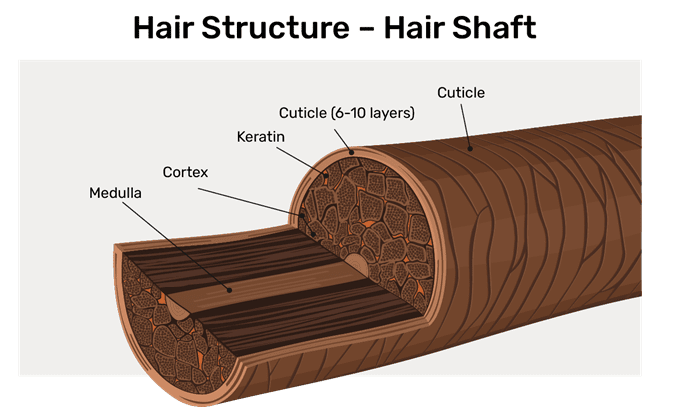
When it comes to “hair care” most people think about the keratinous fibres sticking out of our scalp. It is surprising that only few think about scalp health when it comes to growing healthy hair. Scalp health is paramount to hair health. Think of scalp as soil to your hair strands, if deprived of nutrients it simply cannot feed healthy hair.
The most common split of hair is medulla, cortex and cuticle. The innermost part, the core of your hair strand – is called medulla. Cortex which makes up the “meat” of the hair strand, consisting of keratin. A cuticle is the outermost layer of the hair strand which looks like roof shingles.
However it is also logical to divide hair in three other parts: hair root – that’s hidden in the subcutaneous tissue in your scalp, hair length – hair that is on display with the exception of the third part: hair ends – which is about 1-2 inches of the “last” hair length. For people with very short hair, hair ends and hair lengths will comprise the same thing.

Three Parts of Hair Strand
These distinct three parts call for different care routes. The fundamental part of hair is known as “hair follicle” and located just beneath the surface of the scalp, in the epidermis. Hair follicle needs sufficient nutrients to grow hair. So, in order to make your hair grow fast and healthy, you need to focus on the hair follicle or hair root and what feeds it: blood flow.
Secondly, to make sure that you keep the length of the hair that you’ve grown and you don’t need to constantly trim it – thus losing all the hair gains, you need to take care of the hair lengths. This can be achieved by adopting a regular hair oiling routine, using protective hairstyles overnight or when exercising and sleeping on a silk pillowcase amongst others. Finally, your hair ends care should include regular trimming if split, oiling and nourishment. To prevent split ends from worsening or occurring altogether you can either visit a salon or engage search & destroy technique at home.
Hair Loss and Mental Health
Since hair follicle plays the most important role in hair growth, let’s take a quick look at the hair that’s already grown. You might already be familiar with Keratin – from shampoo commercials and hair treatments. But what is keratin and why do hair care companies feature Keratin so prominently in their products?
What is Keratin?
Keratin is a combination of amino acids which is a by-product when our body breaks down the protein that we consume. It helps form the tissues of the hair, nails and skin. Our hair is made up of 85-90% of keratin. Thus protein isn’t only important for muscle building. According to dietary recommendations, an average person needs around 0.8 grams of protein per every kilogram of body weight.
Your body identifies the areas low in amino acids and determines which part requires a top up. Because hair growth is a non-essential function to our survival, if you have lower protein levels, you could easily deprive your hair of the needed boost and which can lead to hair breakage and hair loss due to insufficient protein intake.
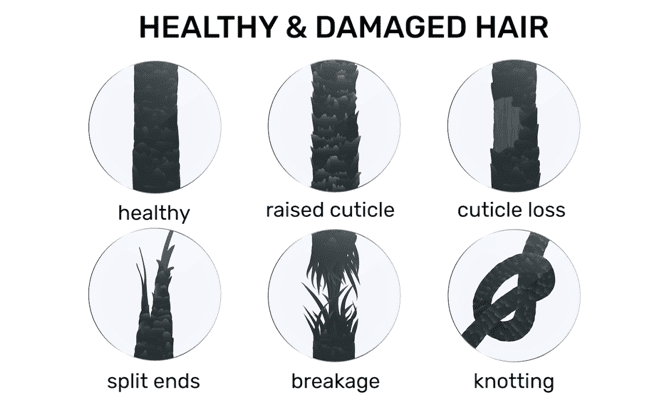
Environmental factors, products we put into our hair, harsh styling techniques and the lack of nutrients can make your hair lose its luster and shine. By infusing Keratin into the hair through a treatment, it will smoothes frizzy and damaged hair for a time. A quick fix, not sustainable or ideal in the long run as it involves harmful chemicals such as formaldehyde – a harmful chemical also known to lead to hair loss, and the process of sealing keratin into the hair involves using high heat which damages the strand – which becomes visible once the treatment fades.
However, knowing this basic role of protein in your nutrition, it’s logical to simply calculate and include a sufficient amount of protein in your diet or supplementation, as opposed to a quick fix of damaging keratin treatment.
Hair Health and Products
You should always examine ingredients of your hair products – whether it being shampoo, a conditioner, a leave-in treatment or a hair spray. For example, non-soluble silicones cause product build up in hair lengths – effectively suffocating the hair strand. Although after one application, your hair might feel shiny and smooth – due to the layer of silicones enveloping it, over time, this leads to dull and brittle hair. In addition silicones in hair care products also cause product build up on the scalp, too, therefore clogging hair follicles and stunting healthy hair growth. To know more about it, read this.
While silicones are common additives to conditioners, in shampoos you need to look out for harsh sulfates. Sulfates are added to destroy and penetrate the fatty cell membrane to remove the oil your scalp naturally produces as well as capturing the sweat, dirt and dust accumulating on your scalp. However harsh sulfates strip the scalp of too much natural oil – thus leaving you with dry and flaky scalp and disturbing natural oil balance – one of the biggest arguments against washing your hair every day. In addition to worsened scalp health, harsh sulfates also strip off the natural oil from the hair strands themselves – thus leading to hair breakage and split ends.
The Hair Growth Cycle
Each hair follicle over our lifetime goes through three distinct stages of being: anagen (growth), catagen (transition), and telogen (resting) multiple times. These states are dependent on the given blood and nutrient supply to each follicle. A follicle with a healthy support system will remain in the anagen phase until that support system is compromised in some way (3) and can go through these stages multiple times.
At any given time, 85-90% of our hair follicles are in anagen stage – which takes about 2-7 years, about 3% in catagen º which takes 10-14 days as the hair detaches itself from the blood supply – and about 10-15% of hair follicles are resting in the telogen stage – that takes 3 months during which hair leaves the follicle entirely.
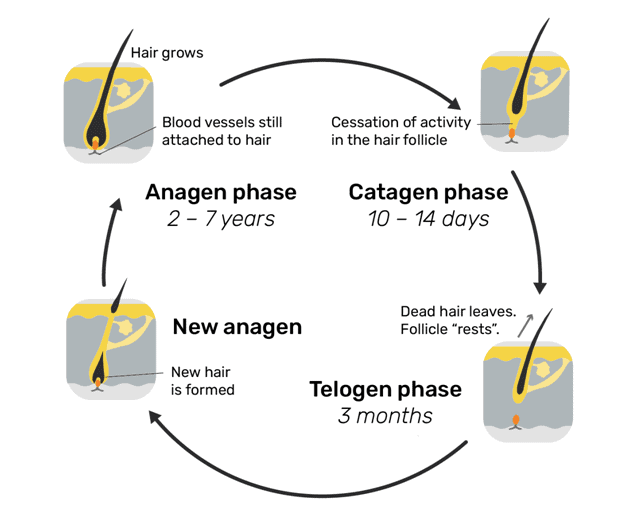
Hair Loss Cycle
This growing schedule is most commonly disturbed by what’s known as stress-related hair loss – or telogen effluvium – whereby more hair follicles go simultaneously into a resting stage. This leads to more shedding than usual, resulting in visible and noticeable hair fall – more hair in shower drain and pillow and even bald spots. Due to the duration of telogen stage, stress-related hair loss tends to occur about 3 months within an onset of a stressful event. Telogen effluvium is effectively stopped when you can notice a “halo” of small hair regrowth around your scalp. This means that the main offender – stress is over – and your body can stop its only attention to life-essential functions – and begin to support hair growth again.
The only reason why anyone would lose hair is if the body did not possess the physical means of supporting said hair, or physically being prevented from growing – such physical obstacles being explored later in this article. If the body cannot afford to produce and maintain hair, it places hair growth on pause – so most of the time you are not losing hair forever, but your hair follicle essentially hibernates.
Scalp Function in Hair Growth
Why would nutrients be prevented from reaching hair follicles thus interrupting the natural process of hair growth? The answer lies in the anatomy of the scalp itself. Known as the galea aponeurotica is a muscle in your scalp – a sheet of connective tissue with muscular attachments on each side. Controlled by the opposing frontalis (front part) and occipitalis (back part), the galea aponeurotica allows for the transfer of force across the top of the head. For humans maintaining this force is what helps our upright posture, specifically of the head and skull.
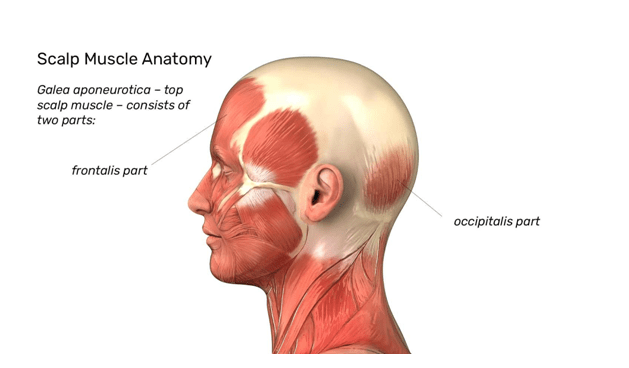
Blood Flow in Scalp Muscle
Aside from its importance in posture, the galea aponeurotica and its surrounding muscles also play a role in influencing the flow of blood to the scalp. Just as other skeletal muscles and blood vessels help transport bodily fluids, so do the muscles atop of your head. So when there is a dysfunction in this muscle, hair loss can begin to manifest.
For illustration, take a look at the image below. Blood supply to the top of the head originates from the branches off the internal carotid, and external carotid arteries which travel from the side to the front of the skull. Notice how the arteries become thinner and more dispersed towards the top of the head. Because of this structure, these arteries are more dependent on the muscle contraction (or relaxation) for blood flow – the latter bringing nutrients to the tissues.
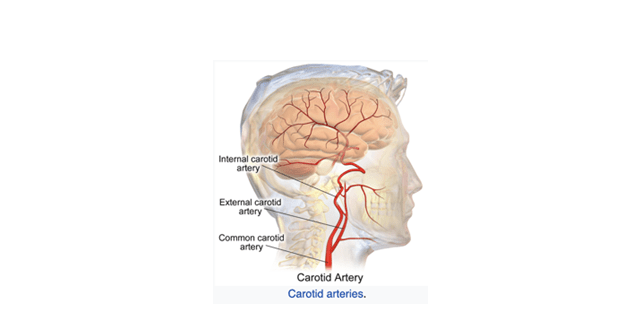
If your scalp muscles have reduced or in any other way impaired, then the blood supply to the scalp will become impaired too, which can lead to hair loss and hair thinning – as the follicles become starved from oxygen and nutrients. So no wonder, that hair loss occurs in the crown area first in both, men and women. This is where the tension is at its highest and blood supply is less as compared to the sides of the head.
If that is the case, how come not everyone is losing hair at the crown area? There are other factors at work here but less blood flow activity is the first culprit.
Hormones and Hair Loss
Hair loss occurs more frequently in men, known as male pattern baldness related to the effects and transmutation of androgens – male sex hormones. However women too can – and do – suffer from similar, androgenetic hair loss, the latter can be a result of a condition (PCOS) or stress-related hair loss, as triggered by the elevated cortisol levels that leads to increased androgen production in women.

DHT and Androgens in Hair Follicle Interaction
In times past, a hormone known as Dihydrotestosterone (DHT) which is more dominant in men was believed to be the reason for hair loss as it was thought to miniaturize hair follicles leading to hair loss. But this was disproved upon the discovery that DHT actually causes thicker hair to some areas of the body during puberty. This controversially demonstrates that DHT should promote hair growth, not cause hair thinning!

However, newer studies show that DHT’s contribution to hair loss is through gravity, fat loss, fibrosis and calcification. DHT, along with other androgens, support oxidation of fat cells: the very reason behind men naturally being leaner than females. However DHT also fights inflammation, so when galea neurotica becomes inflamed due to muscle tension, DHT is “sent” by your body to put out that inflammation. This way, increased localized DHT in males and females with elevated androgens destroy subcutaneous fat in the scalp. This means that the blood vessels become more compressed by the skin from the force of gravity. Blood flow is therefore reduced and DHT accumulates at the top of the head. This extra DHT then contributes to fibrosis and scalp calcification of soft tissue further restricting movement of the scalp leading to the formation of a bone-like texture around the hair follicle.
Dermarolling and Blood Flow to Scalp
Since the 1980s, a medicated route to treat male-pattern hair loss was devised, by means of finasteride, commercially known as Propecia. While many users report less hair fall and improved hair thickness, users of the medication also report noticeable side effects related to sexual and reproductive health in males and not even prescribed to females altogether. In addition, taking a hormone-altering supplement that affects your entire body only to help hair grow locally – is hard to compare in magnitude and akin to shooting sparrows with a cannon.
A number of other techniques and tools have reportedly shown promising results to aid hair growth in clinical settings, namely improving blood flow to scalp locally by means of either scalp massage or derma rolling or dermastamping your scalp. These offer hormone-free and sustainable solutions for challenges with hair growth. Dermarolling, or also known as microwounding, also works for women and female pattern hair loss affecting women predominantly in and around menopause. Dermarolling also helps production of localised collagen – around hair follicles lining the hair follicle and contributing to hair thickness. As tiny needles leave microscopic wounds around the scalp, body sends extra collagen to repair those micro-injury as well as improving blood flow to the affected area.
Cortisol, Stress-Related Hair Loss and Scalp Inflammation
We mentioned that one of the greatest threats to hair growth is stress in any form. Specifically cortisol – a stress hormone produced by the adrenal glands in the periods when stress levels are high. Whether from a stressful work project, or over-exercising, tackling it can be more difficult, since the effects of stress on hair don’t kick in until 3 months after the onset of a stressful event. And since hair isn’t prioritised as an important, life-supporting function, your body will skimp on sending the extra nutrients to the scalp during the recovery process, until all other life-supporting functions are in balance.
Stress response suspends a number of our bodily functions: digestion and tissue construction being one of them. For example, one of the reasons why stressful life leads to more wrinkles, is because cortisol destroys collagen which impacts skin elasticity and youthful appearance. As cortisol affects digestion, it also negatively impacts our body’s ability to transform food and supplements we consume, to fuel our body and its processes – including hair growth.
This process wouldn’t affect our hair growth in such a profound way, if it wasn’t for prolonged periods of stress: hair is seen by our body as a “luxury” and therefore stands at the end of the priority line when nutrients are being distributed by our body processes. Living with too much psychological or physical stress will degrade your body’s ability to maintain healthy hair. Stress can manifest as a physical muscle tension, which will affect galea neurotica thus leading to scalp inflammation and hair loss.
Thyroid-Related Hair Loss
There is another hormone, produced by your thyroid gland which impacts the health and thickness of your hair – T3 and T4. In the case of underactive thyroid, body doesn’t produce sufficient amounts of these hormones to promote proliferation of keratinocytes – epidermal cells responsible for production of keratin, necessary for growth of healthy hair – which greatly reduces the ability of the hair follicle to grow hair. In thyroid-related hair loss and hair growth challenges, hair growth becomes a function you need to manage.
Without looking and treating the root cause of the problem, thus managing the hormones, as well as locally supporting function of hair growth through improving scalp blood flow – healthy hair growth for people with thyroid conditions becomes impossible. The support for the hair follicle needs to come from within through adequate intake of vitamins and supplements and changes in lifestyle as well as externally – topically by way of improving blood flow to scalp in order to help scalp grow healthy hair with more ease.
Diet & Nutrition Role in Scalp Care for Hair Growth
Another important factor in the question of hair loss and hair growth is your diet and nutrition. Specific deficiencies are difficult to pinpoint without proper blood test, and you can have different sensitivity to androgens and scalp tension. But that’s where the local effort in supporting blood flow to the scalp becomes key. It effectively signals your body through improved localised blood flow – that “this is where the nutrients should be sent”.
While some restrictive diets may also be a result of a medical condition – any restrictive diet can impact our ability to consume sufficient amounts of nutrients. Therefore a simple multi-vitamin can go a long way in supporting your body not only during periods of stress but also if for any reason you need to maintain a restricted diet and therefore are unable to easily obtain necessary nutrients from food for hair.
Conclusion
Hair loss is indeed reversible. The solutions, however, are not instant fixes, but profound and fundamental lifestyle changes that benefit your entire body and hair regrowth being a great by-product. Managing stress in a sustainable way – through the means of exercise and mindfulness practices – as well as supplementation (e.g. iron, magnesium) will improve physical integrity of the craniofacial muscles as well as blood flow to the scalp. With the latter, a number of techniques and scalp care rituals can be adopted to support your scalp in growing healthy hair. Such techniques include microneedling (a.k.a. dermarolling) of scalp, scalp massages, certain scalp treatments amongst others.
Who we are:
The Hair Fuel is an all-natural hair growth mask created by Laura Sagen, who lost a third of her hair after a terrible visit to a hairdresser while suffering from a life-long condition of PCOS associated with androgenic hair thinning. She developed the formulation rooted in the science of scalp blood flow, which has become The Hair Fuel growth mask. Since then, her company has helped thousands of people like you to start growing healthy hair.
We work closely with our lab and manufacturers to ensure the highest quality product. But a product alone is never enough – so we hold your hand throughout your own, unique hair growth journey. Our flagship product, The Hair Fuel mask coupled with tailored advice, digital tools, and online support is there to help you grow the best hair you can. It’s a big claim – but we’re unafraid to make it. Check out our starter bundles >>
